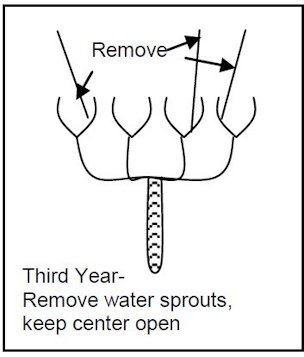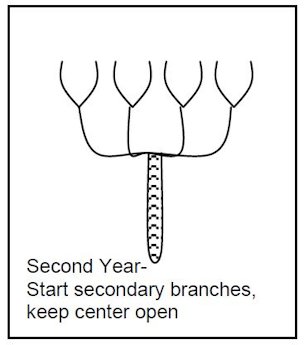Fact Sheet from
the Just Fruits and Exotics Nursery
by Brandy Cowley Gilbert
Peach, Plums and Nectarines
Introduction
Peaches
are the emblem of Southern summer, now joined by nectarines bred for
the humid South. Plums were native here, and are a close relative of
peaches and nectarines. If you want sweet, juicy peaches, plums or
nectarines, take the time to grow your own—storebought ones are
picked green and rarely resemble the real thing.
The Louisiana
State University program has been a great breeder of delicious and
disease resistant varieties and both the University of Georgia and the
University of Florida have released many great varieties. All peaches
and nectarines are self fertile so plant one or fill your orchard! But,
plums require cross pollination, so leave room for at least two trees.
Uses in the Landscape
Each season provides its own kind of beauty with peaches, plums and nectarines.
Spring
brings billows of fragrant pink to red flowers like cotton candy
clouds, followed by months of beautiful fruit changing from green to
yellow, gold, peachy red or purple. In fall, leaves turn bright yellow.
Standard-sized trees can be used as small shade trees or as part of a
fruitful border. When full grown, the willowy trees are 12-18 feet
tall. Mix peaches, plums and nectarines with smaller fruits such as
blueberries, blackberries, figs and pomegranates. Group them along a
pathway so you can enjoy them close up!
Planting and Culture
Site Selection
Well-drained,
sandy loam soils are preferred, but peaches, plums and nectarines will
grow on many soil types if good drainage is provided. Peaches, plums
and nectarines will grow more vigorously and produce more fruit in full
sun. Avoid frost pockets – trees may be damaged by unseasonable
frosts.
Soil Preparation and Planting
Peaches,
plums and nectarines prefer slightly acid soil (pH 6.0 - 6.8). If you
are in doubt about the acidity of your soil, take a soil sample to the
Cooperative Extension Agent in your county for a soil test.
Dig
a planting hole approximately three times the width of the pot and at
the same depth as the root ball. Set that soil aside and mix it 50/50
with either aged mushroom compost, aged manure, or rotted pine bark
& aged manure/compost. Remove the plant from the pot, gently loosen
the root ball, cut any roots that swirl around the edges of the root
ball, and place the tree in the planting hole. To avoid burying too
deep, make sure plant is positioned with the top most roots at the soil
line. Fill the planting hole with the mix of soil and organic matter;
gently tamp it in. Water thoroughly to settle the roots and eliminate
air pockets. Do NOT put fertilizer in the planting hole. Only apply
fertilizer if it is the correct time of year (see Fertilization section
below).
If desired, construct a water basin around the base of
the tree approximately 36 inches in diameter. Mulch in spring and
summer with approximately 4-6 inches of mulch. In spring, we suggest a
mix of compost and weed-free hay as mulch. Pull mulch a couple of
inches away from the trunk for good air circulation. In summer, use
weed-free hay or grass clippings alone.
Spacing for peaches,
plums and nectarines depends upon the desired use in the landscape, but
in general trees should be at least 20 feet apart. Put plums
approximately 20 feet apart for cross pollination. Refer to the Orchard
Care Fact Sheet for details of peach, plum and nectarine care
throughout the year.
Fertilization
The
type of fertilizer you choose may be chemical or organic. Make sure
that the fertilizer contains iron, zinc, manganese, magnesium,
molybdenum, copper and boron. These minor elements are very important
to plants and most soils are low in these elements. Application rates
vary according to age of plant. See chart below.
10-10-10 or 10-0-10
with minerals | 1 cup per each year of tree’s life
Max out at 9 cups for Mature tree | Espoma Citrus Tone
(Organic) | 6 cups for 1 year old
10 cups for 2 year old (4-6ft)
18 cups for 7-9ft tree
24 cups for tree over 9ft |
Spread
the fertilizer evenly under the entire canopy of the plant avoiding a
5-inch area around the trunk. Water or rake in. For Zones 8a-10,
fertilize 3 times each year in late February, late May and late July.
Never fertilize after August as this will promote new growth late in
the year which will be subject to freeze damage.
Water
The
first year is a critical time for the establishment of a new peach,
plum or nectarine tree. Water thoroughly twice a week on light soils or
once a week on clay soils. Soak the entire root system deeply –
this usually takes 40-50 minutes.
Established trees should receive
at least 1 inch of water each week. Water regularly, especially during
dry periods. Fruit may drop prematurely if insufficiently irrigated
during dry spells.
Pruning and thinning
Peaches, plums and nectarines in the South are usually pruned to an open center habit.

Fig. 1
At planting select 3-4 scaffold branches spaced equally around the trunk and remove other branches flush with the trunk.
In
the second dormant season, top the scaffold limbs approximately 36
inches from the trunk to encourage secondary branching. Remove any
strong branches growing into the center. You want the tree to have good
air circulation in the interior.

Fig. 2
Continue
to train peach, plum and nectarine trees during the first 5 years.
Pruning should be designed to train the tree outward by removing strong
branches growing into the center and removing water sprouts. The tree
can be topped out at 7 or 8 foot with mold and hold cuts, which are
de-vigorating heading cuts made into two year old wood. Do this by
topping back the main scaffold limb to a weaker outward growing shoot.
This will keep the tree at an easy picking height as well as stimulate
new growth lower on the tree.

Fig. 3
Mature
trees are pruned during the dormant season. Thin out weak branches and
head back long shoots as needed to maintain tree shape. Remove water
sprouts. Remove any dead, damaged or diseased branches when pruning.
Use mold and hold cuts to maintain trees to an easy picking height.
To
grow the biggest peaches, plums and nectarines, thin small fruit to no
more than 1 fruit per 6 inches of branch. We know this hurts, but
you’ll be rewarded with the sweetest, biggest fruit your tree can
produce.
Orchard Care
Peaches,
plums and nectarines need a little help to be productive. Check with
your extension agent for specific recommendations for your area. White
peach scale can be controlled by dormant oil sprays at leaf fall and
bud break. This is highly recommended as an annual maintenance spray.
Brown rot can be prevented by using a wettable sulphur spray every 2
weeks while fruit is ripening. Pack wood ashes around the base of your
tree to fend off peach tree borers. Happy eating!
Tropical Peaches: All peaches are self-pollinating.
Florda Prince: Tropical peach bred for 150 chill hours. Medium-sized, deep red-skinned peach with a soft,
semi-cling yellow center. Ripe mid-May. Zone 9.
Tropic Beauty: A red-skinned semi-freestone peach for 150 chill hours. Delicious! Ripe mid-May. Zone 9.
Tropic Snow: White peaches in Tampa! A freestone, low-acid, super-sweet peach. 200 chill hours. Ripe mid-
May. Zone 9.
UFO: A new saucer peach from the University of Florida. Derived from an old Asian favorite that Chinese
emperors loved since they could eat it without dripping delicious juice onto their long beards (really!). 250 chill
hours. Ripe May. Zone 9.
For more varieties go to our website justfruitsandexotics.com
Back to
Peach Page
|
|
Bibliography
Gilbert, Cowley, Brandy. "Peach, Plum and Nectarines." Just Fruits and Exotics nursery, justfruitsandexotics.com. Accessed 17 Apr. 2015.
Drawings
Fig. 1,2,7 Gilbert, Cowley, Brandy. "Peach, Plum and Nectarines." Just Fruits and Exotics nursery, justfruitsandexotics.com. Accessed 17 Apr. 2015.
Published 17 Apr. 2015 LR
|